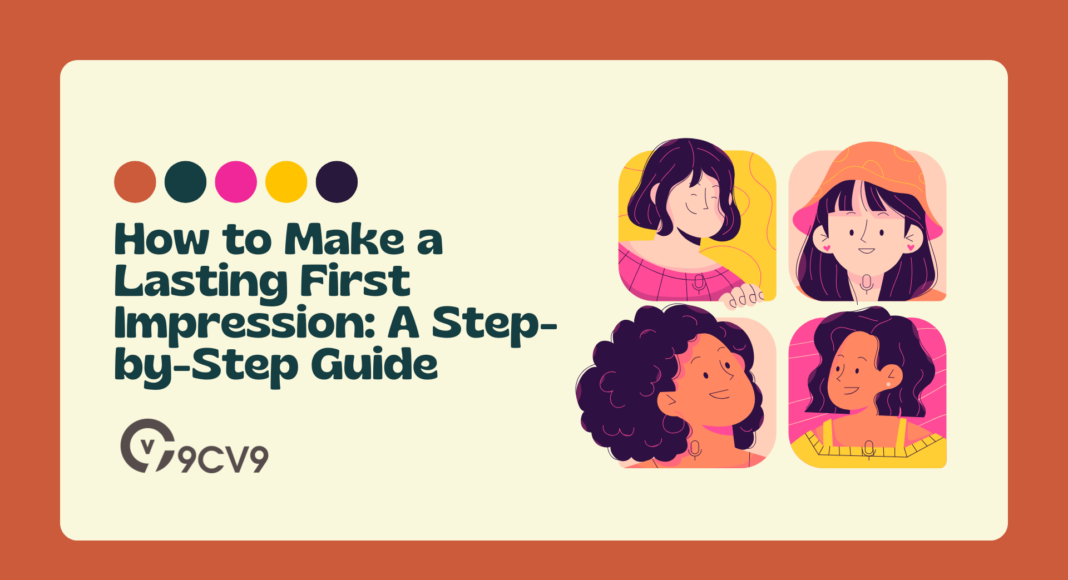Key Takeaways
- Master the Art of Preparation: Understand your audience and rehearse key points to tailor your approach, ensuring a confident and engaging presence.
- Engage Effectively: Utilize active listening, positive body language, and meaningful conversation to create connections that resonate and leave a lasting impact.
- Follow Up Thoughtfully: Reinforce your initial encounter with a personalized follow-up message to express gratitude and keep the conversation alive, strengthening the relationship.
In today’s fast-paced world, the importance of making a lasting first impression cannot be overstated.
Whether in a professional setting, a social gathering, or a casual encounter, the initial moments of any interaction are crucial in shaping perceptions and influencing relationships.
Research suggests that it takes only seven seconds to form a first impression, a fleeting moment that can significantly impact future interactions.
This immediate evaluation often hinges on various factors, including appearance, body language, and communication skills, all of which play a pivotal role in how we are perceived by others.

The significance of first impressions extends beyond mere introductions; they set the tone for future interactions and can determine the trajectory of personal and professional relationships.
In the business realm, a positive first impression can lead to fruitful partnerships, job opportunities, and successful networking.
Conversely, a negative impression may hinder progress, limit opportunities, and even lead to miscommunication or conflict.
Therefore, mastering the art of making a memorable first impression is an invaluable skill that can enhance one’s social and professional life.
Moreover, first impressions are not solely about the immediate encounter; they have lasting effects on how individuals are remembered and valued.
Psychological studies indicate that people tend to maintain their initial judgments, often reinforcing their perceptions over time.
This phenomenon highlights the necessity of presenting oneself in a manner that fosters trust, respect, and authenticity right from the start.
This guide aims to equip you with actionable insights and practical strategies for making a positive and enduring first impression.
From the critical preparation that lays the groundwork for your encounter to the nuances of engaging effectively in conversation, we will delve into each step necessary for crafting an impression that resonates positively with others.
Additionally, we will explore the importance of follow-up interactions in maintaining connections and ensuring that the initial impact endures long after the first meeting.
In this step-by-step guide, you will discover the foundational elements that contribute to a compelling first impression, including the significance of attire, body language, and conversational skills.
We will also discuss common pitfalls to avoid, ensuring that you are well-prepared to navigate various social situations with confidence and grace.
Ultimately, making a lasting first impression is not just about superficial appearances; it is about presenting your authentic self in a way that resonates with others.
By cultivating the skills outlined in this guide, you will not only improve your chances of making a favorable impression but also enhance your overall interpersonal communication skills, enabling you to build deeper and more meaningful connections.
So, whether you are preparing for a job interview, attending a networking event, or simply meeting new people in your daily life, this comprehensive guide will serve as your roadmap to success in making lasting first impressions.
Let’s embark on this journey together and unlock the secrets to leaving an unforgettable mark on everyone you meet.
Before we venture further into this article, we would like to share who we are and what we do.
About 9cv9
9cv9 is a business tech startup based in Singapore and Asia, with a strong presence all over the world.
With over eight years of startup and business experience, and being highly involved in connecting with thousands of companies and startups, the 9cv9 team has listed some important learning points in this overview of How to Make a Lasting First Impression.
If your company needs recruitment and headhunting services to hire top-quality employees, you can use 9cv9 headhunting and recruitment services to hire top talents and candidates. Find out more here, or send over an email to [email protected].
Or just post 1 free job posting here at 9cv9 Hiring Portal in under 10 minutes.
How to Make a Lasting First Impression: A Step-by-Step Guide
- Understanding First Impressions
- Preparing for Your Encounter
- Making Your Entrance
- Engaging in Conversation
- Following Up After the Encounter
- Common Pitfalls to Avoid
1. Understanding First Impressions

First impressions are powerful and often irreversible judgments formed within seconds of encountering someone new.
This section delves into the critical components of first impressions, their psychological basis, and the factors that influence how they are formed.
Definition of a First Impression
- A first impression is the initial evaluation made when meeting someone for the first time.
- It encompasses various factors, including appearance, body language, and verbal communication.
- First impressions can be influenced by social, cultural, and situational contexts.
The Impact of First Impressions
- Duration: Research shows that first impressions can last for years. Once formed, they are challenging to change.
- Social Perception: First impressions can affect how we are perceived in social and professional situations, impacting career opportunities, friendships, and relationships.
- Decision Making: People often base significant decisions, such as hiring or forming partnerships, on first impressions.
- Trust and Credibility: A positive first impression fosters trust and credibility, while a negative one can lead to skepticism and doubt.
Psychological Aspects of First Impressions
- Cognitive Bias: The halo effect is a cognitive bias where positive traits in one area (like appearance) influence perceptions in other areas (like intelligence or competence).
- Example: An attractive candidate may be perceived as more capable or friendly, regardless of their actual qualifications.
- Confirmation Bias: Once a first impression is established, individuals tend to seek information that confirms their initial judgment while disregarding contradictory evidence.
- Example: If someone perceives another as unfriendly during their first meeting, they might interpret all subsequent interactions through that lens, reinforcing their initial judgment.
Factors Influencing First Impressions
- Appearance
- Dress Code: Clothing plays a crucial role in shaping perceptions. For instance, wearing business attire may convey professionalism, while casual wear could suggest a relaxed attitude.
- Grooming: Personal hygiene and grooming habits significantly impact first impressions. A well-groomed individual is often viewed as more responsible and detail-oriented.
- Example: A job candidate dressed in a tailored suit is more likely to be perceived as competent and serious than one in jeans and a t-shirt.
- Body Language
- Posture: Open and confident posture can signal self-assurance, while slouched shoulders may convey insecurity.
- Eye Contact: Maintaining appropriate eye contact demonstrates confidence and engagement. Conversely, avoiding eye contact may suggest dishonesty or discomfort.
- Facial Expressions: A genuine smile can create a warm and inviting atmosphere, fostering a positive connection.
- Example: A candidate who enters an interview with a straight posture, steady eye contact, and a smile is more likely to leave a positive impression than one who appears closed off or disinterested.
- Verbal Communication
- Tone of Voice: The tone can convey enthusiasm, confidence, or uncertainty. A warm, friendly tone can enhance the impression you make.
- Choice of Words: Using clear, articulate language demonstrates intelligence and preparedness. Avoiding filler words like “um” or “like” can help maintain a professional image.
- Active Listening: Demonstrating genuine interest by actively listening and responding appropriately can create a favorable impression.
- Example: During a networking event, a person who engages others with thoughtful questions and attentive listening is likely to be remembered positively.
Cultural Influences on First Impressions
- Different cultures have varying norms regarding greetings, personal space, and eye contact.
- Understanding cultural nuances is vital for making a good first impression in diverse settings.
- Example: In some cultures, a firm handshake is expected, while in others, a light touch or bow is more appropriate. Misunderstanding these customs can lead to awkward situations.
Conclusion
Understanding the multifaceted nature of first impressions is essential for anyone looking to enhance their social and professional interactions.
By recognizing the psychological principles at play and the various factors that influence perceptions, individuals can better prepare themselves to create positive and lasting impressions.
Armed with this knowledge, you can approach every new encounter with confidence, ensuring that you leave a mark that resonates positively long after the initial meeting.
2. Preparing for Your Encounter

Effective preparation is key to making a lasting first impression.
By carefully considering various aspects before your encounter, you can boost your confidence and ensure that you present yourself in the best possible light.
This section outlines the critical elements of preparation, providing actionable tips and relevant examples to help you succeed.
Research Your Audience
Understanding who you are meeting can greatly enhance your ability to connect and communicate effectively.
- Know Your Audience
- Gather information about the individuals or group you will meet.
- Research their backgrounds, interests, and professional roles.
- Example: If you are meeting a potential client, researching their company’s mission and values can help you tailor your conversation to align with their goals.
- Tailor Your Approach
- Customize your communication style based on your audience’s preferences.
- Use language and examples that resonate with them, showing that you value their perspectives.
- Example: When meeting with tech-savvy individuals, using industry-specific terminology can establish credibility and rapport.
- Understand the Context
- Be aware of the purpose of the meeting and the environment in which it will take place.
- Consider whether the meeting is formal or informal, and adjust your approach accordingly.
- Example: A casual coffee meeting allows for a more relaxed conversation compared to a formal job interview.
Dress the Part
Your attire significantly influences first impressions and should align with the context of the encounter.
- Appropriate Attire
- Choose clothing that is suitable for the occasion, considering factors like the setting and cultural norms.
- Example: For a business meeting, wearing a tailored suit conveys professionalism, while a smart casual outfit might be more appropriate for a networking event.
- Grooming Matters
- Pay attention to personal hygiene and grooming, as these contribute to your overall appearance.
- Maintain clean hair, nails, and skin to project a polished image.
- Example: A candidate who arrives at an interview with well-groomed hair and neat attire is likely to be viewed more favorably than one who appears disheveled.
- Color and Style Choices
- Understand the psychology of colors in clothing, as different colors can evoke different perceptions.
- Example: Blue is often associated with trust and professionalism, while red can convey confidence and energy. Choose colors that align with the impression you wish to make.
Mindset Matters
Your mental state before an encounter can profoundly influence how you present yourself and interact with others.
- Cultivate Confidence
- Engage in positive self-talk to boost your confidence before the encounter.
- Visualize a successful meeting, imagining yourself making a strong impression.
- Example: Practicing affirmations such as “I am confident and capable” can help set a positive tone for the encounter.
- Manage Anxiety
- Employ relaxation techniques, such as deep breathing or mindfulness, to reduce anxiety before high-stakes meetings.
- Prepare yourself mentally by reviewing your goals for the encounter.
- Example: Taking a few moments to breathe deeply before entering a meeting room can help calm nerves and improve focus.
- Set Clear Objectives
- Identify what you hope to achieve from the encounter, whether it’s building rapport, securing a job, or networking.
- Write down specific goals to clarify your intentions.
- Example: If you aim to secure a follow-up meeting, plan how you will express this at the end of the encounter.
Practice Makes Perfect
Rehearsing your interactions can enhance your confidence and effectiveness in communication.
- Role-Playing Scenarios
- Practice potential conversation scenarios with a friend or mentor to prepare for various responses and questions.
- Example: If you anticipate difficult questions during an interview, rehearsing answers can help you respond more confidently.
- Elevator Pitch
- Prepare a concise and engaging elevator pitch that summarizes who you are and what you do.
- Aim for 30-60 seconds to capture attention and interest.
- Example: “Hi, I’m Jane, a digital marketing specialist with a passion for social media strategy. I’ve helped companies increase their online engagement by 50% through targeted campaigns.”
- Feedback Loop
- Seek constructive feedback from trusted peers on your presentation style, body language, and communication.
- Use their insights to refine your approach and enhance your effectiveness.
- Example: Recording yourself during practice conversations can help you identify areas for improvement.
Gather Necessary Materials
Being prepared with relevant materials can boost your confidence and demonstrate professionalism.
- Business Cards
- Ensure you have a sufficient supply of business cards to distribute during networking events or meetings.
- Example: A well-designed business card can leave a lasting impression and provide a tangible reminder of your encounter.
- Portfolio or Samples
- If relevant, prepare a portfolio or samples of your work to showcase your skills and experience.
- Example: A graphic designer might bring a tablet with a digital portfolio of their projects to visually engage potential clients.
- Notes and Questions
- Prepare notes on key topics you wish to discuss and questions you want to ask.
- This preparation shows your genuine interest and ensures you make the most of the opportunity.
- Example: In a job interview, preparing thoughtful questions about the company culture can demonstrate your enthusiasm and engagement.
Conclusion
Thorough preparation is essential for making a lasting first impression.
By researching your audience, dressing appropriately, cultivating a confident mindset, practicing your interactions, and gathering necessary materials, you can ensure that you present yourself in the best possible light.
With these strategies in hand, you’ll be well-equipped to navigate any encounter and create a positive and memorable impression that resonates long after your meeting concludes.
3. Making Your Entrance

The way you enter a room or situation plays a significant role in shaping the first impression you make.
A confident and poised entrance sets the tone for the interaction and establishes your presence.
This section provides comprehensive guidance on how to make a memorable entrance, highlighting essential elements that contribute to a positive initial perception.
Timing and Presence
Being punctual and attentive when entering a space can greatly influence the reception you receive.
- Arrive on Time
- Punctuality demonstrates respect for others’ time and indicates reliability.
- Arriving late can create a negative impression before you even begin the conversation.
- Example: Arriving five to ten minutes early for a job interview allows you to settle in, gather your thoughts, and make a calm entrance.
- Pause Before Entering
- Take a moment to gather yourself before entering a room. This allows you to project confidence and composure.
- Observe the environment and assess how to best engage with those present.
- Example: Taking a deep breath and standing tall for a few seconds before stepping into a networking event can help you exude confidence.
- Use the Entrance as an Opportunity
- Make your entrance count by utilizing the moment to capture attention positively.
- Smile and engage with people upon entry, which helps set an inviting atmosphere.
- Example: Upon entering a meeting room, making eye contact and greeting everyone with a warm smile establishes rapport from the start.
Body Language
Your body language during your entrance communicates a wealth of information about your confidence and attitude.
- Posture
- Stand tall with shoulders back to convey confidence and openness.
- Avoid slouching or appearing closed off, as this can signal insecurity.
- Example: A candidate who walks into an interview with an upright posture appears more self-assured and ready for engagement.
- Facial Expressions
- Approach the situation with a friendly demeanor, as a genuine smile can disarm and engage others.
- Maintain an approachable expression to invite conversation and connection.
- Example: Entering a social gathering with a smile and a welcoming expression encourages others to engage with you.
- Gestures
- Use purposeful gestures to enhance your communication and express enthusiasm.
- Avoid fidgeting or crossing your arms, as these can be interpreted as signs of discomfort or defensiveness.
- Example: Using open-handed gestures when speaking can convey openness and sincerity.
Verbal Communication
How you introduce yourself and engage in conversation upon entering is crucial for making a lasting impression.
- Articulate a Strong Greeting
- Begin with a friendly and confident greeting that establishes a positive tone.
- Use the person’s name to create a personal connection and demonstrate attentiveness.
- Example: “Hello, everyone! My name is Sarah, and I’m excited to be here today to discuss our collaboration opportunities.”
- Maintain a Conversational Tone
- Speak clearly and confidently, using a warm tone to create an inviting atmosphere.
- Engage in small talk to break the ice and establish rapport.
- Example: Asking a simple question like, “How has your day been so far?” can encourage dialogue and ease any initial tension.
- Be Prepared for Responses
- Anticipate possible reactions and be ready to respond appropriately.
- Engaging actively with responses demonstrates your willingness to connect.
- Example: If someone responds with a question about your background, sharing a concise and relevant story can deepen the conversation.
Make Eye Contact
Eye contact is a powerful tool in communication, conveying confidence and engagement.
- Connect with Each Person
- When entering a room, make eye contact with individuals, acknowledging their presence and inviting interaction.
- This helps create a sense of connection and shows that you value their presence.
- Example: In a group setting, scanning the room and making brief eye contact with multiple attendees can foster a sense of inclusiveness.
- Sustain Eye Contact During Interactions
- Maintaining eye contact during conversations indicates attentiveness and sincerity.
- Aim for a balance, avoiding excessive staring that may make others uncomfortable.
- Example: When discussing a topic, looking the speaker in the eye reinforces your interest and engagement in the conversation.
Adapt to the Environment
Being adaptable and aware of your surroundings allows you to make a fitting entrance.
- Assess the Atmosphere
- Take note of the room’s vibe and adjust your approach accordingly. A formal setting may require a more reserved entrance, while a casual gathering allows for a relaxed demeanor.
- Example: In a formal business meeting, a composed entrance aligns better with the setting compared to a lively approach suited for a social gathering.
- Engage with the Host
- If applicable, acknowledge the host upon entering and express gratitude for the invitation.
- This shows respect and appreciation for the opportunity.
- Example: “Thank you for hosting this event! I’m looking forward to our discussions.”
Practice Mindfulness
Practicing mindfulness helps you remain present and focused during your entrance.
- Stay Grounded
- Ground yourself before entering by focusing on your breath or reciting a mantra.
- This can help calm any nerves and enhance your confidence.
- Example: Taking a moment to breathe deeply and visualize a successful interaction can shift your mindset positively.
- Be Present in the Moment
- Once you enter, engage fully with the people around you, avoiding distractions from your phone or external factors.
- This demonstrates that you value the interaction and those involved.
- Example: Putting away your phone during conversations signifies that you are invested in the present moment.
Conclusion
Making a memorable entrance is a critical step in leaving a lasting first impression.
By being punctual, confident, and engaging in your body language and verbal communication, you can create a welcoming atmosphere that encourages connection.
Being adaptable to your environment and practicing mindfulness further enhances your ability to present yourself authentically.
By applying these strategies, you’ll ensure that your entrance not only captures attention but also sets a positive tone for the entire interaction, paving the way for fruitful connections and relationships.
4. Engaging in Conversation
Engaging in conversation effectively is crucial for making a lasting first impression.
The ability to communicate well can establish rapport, create connections, and leave a positive impact on your audience.
This section outlines essential techniques and strategies for engaging in conversation, providing relevant examples to illustrate how these practices can enhance your interactions.
Active Listening
Active listening is a vital skill that demonstrates your genuine interest in the conversation and the speaker.
- Maintain Eye Contact
- Establish eye contact to show attentiveness and encourage the speaker to share more.
- This nonverbal cue signals that you are fully engaged in the dialogue.
- Example: Nodding and maintaining eye contact while someone shares their thoughts can encourage them to elaborate further.
- Avoid Interrupting
- Allow the speaker to finish their thoughts without interruption, demonstrating respect for their ideas.
- If you feel the urge to interject, jot down your thoughts to address them later.
- Example: In a brainstorming session, letting colleagues express their ideas without cutting in fosters a more inclusive environment.
- Reflect and Summarize
- Paraphrase what the speaker has said to confirm understanding and show you are listening actively.
- Example: “So, if I understand correctly, you believe that improving our social media strategy could enhance our brand awareness?”
Asking Open-Ended Questions
Open-ended questions facilitate deeper discussions and encourage the other person to share more about their thoughts and experiences.
- Encourage Elaboration
- Use questions that require more than a yes or no answer, prompting detailed responses.
- Example: Instead of asking, “Did you like the project?” consider, “What aspects of the project did you find most engaging?”
- Explore Interests
- Inquire about topics that interest the other person, creating opportunities for meaningful dialogue.
- Example: “What inspired you to pursue a career in this field?” invites the speaker to share their journey and passion.
- Follow-Up Questions
- Ask follow-up questions based on the speaker’s responses to demonstrate your interest and keep the conversation flowing.
- Example: If someone mentions a recent trip, ask, “What was your favorite part of the trip?” to deepen the discussion.
Sharing Personal Experiences
Sharing relevant personal experiences can enhance your relatability and strengthen connections.
- Create Common Ground
- Relate your experiences to the topic at hand, allowing the other person to see shared interests or backgrounds.
- Example: “I also faced challenges when starting my own business, especially with marketing strategies.”
- Use Storytelling Techniques
- Narrating your experiences in a storytelling format makes the conversation more engaging and memorable.
- Example: Sharing a brief story about a significant learning moment can resonate with others and encourage them to share their stories.
- Balance Sharing and Listening
- Ensure that your contributions do not overshadow the other person’s input; balance is key in conversation.
- Example: After sharing a brief story, ask for their thoughts or experiences on the subject.
Nonverbal Communication
Nonverbal cues play a significant role in how your message is perceived and can enhance or detract from the conversation.
- Body Language
- Use open body language to convey confidence and approachability. Avoid crossing your arms or turning away from the speaker.
- Example: Leaning slightly forward while engaged in conversation signals interest and attentiveness.
- Facial Expressions
- Match your facial expressions to the context of the conversation; smiling and nodding can create a warm atmosphere.
- Example: A genuine smile when greeting someone can set a positive tone for the conversation.
- Gestures
- Incorporate natural gestures to emphasize points and convey enthusiasm, but avoid overdoing it, as excessive movement can be distracting.
- Example: Using hand gestures to illustrate a point can make your message more engaging.
Being Mindful of Cultural Differences
Cultural awareness is essential in conversation, particularly in diverse settings, as norms may vary significantly across cultures.
- Understand Cultural Norms
- Be aware of different cultural communication styles, including levels of directness and personal space preferences.
- Example: In some cultures, maintaining personal space is vital, while in others, close proximity is more acceptable.
- Adapt Your Approach
- Tailor your conversational style to respect cultural differences, ensuring comfort for all parties involved.
- Example: When engaging with someone from a culture that values indirect communication, be mindful of phrasing and delivery.
- Avoid Assumptions
- Do not assume that everyone shares the same cultural background or values; approach each conversation with an open mind.
- Example: Asking respectful questions about customs can show your interest and willingness to learn.
Handling Difficult Topics
Navigating challenging subjects requires tact and sensitivity to maintain a positive atmosphere.
- Choose Your Words Wisely
- Use neutral language to broach difficult topics, minimizing potential defensiveness.
- Example: Instead of saying, “That’s a terrible idea,” you could say, “I see where you’re coming from; however, have you considered this approach?”
- Stay Calm and Respectful
- Maintain composure when discussing contentious issues, demonstrating respect for differing viewpoints.
- Example: When discussing differing opinions on a project, acknowledge the other person’s perspective before presenting your viewpoint.
- Know When to Pivot
- If a conversation becomes too heated or uncomfortable, gracefully steer the discussion toward a more neutral topic.
- Example: “I appreciate your passion on this topic; perhaps we could explore some other ideas that align with our goals.”
Conclusion
Engaging in conversation effectively is a critical component of making a lasting first impression.
By actively listening, asking open-ended questions, sharing personal experiences, and being mindful of nonverbal communication, you can create meaningful connections.
Additionally, cultural awareness and the ability to navigate difficult topics will further enhance your conversational skills.
By mastering these techniques, you will not only leave a positive impression but also foster relationships that can lead to future opportunities and collaborations.
5. Following Up After the Encounter

Following up after an encounter is an essential component of making a lasting first impression.
It demonstrates your professionalism, reinforces connections, and provides an opportunity to express gratitude or address any outstanding matters.
This section outlines effective strategies for following up, along with relevant examples to illustrate best practices.
Importance of Following Up
Understanding why following up is crucial can help motivate you to take this important step.
- Reinforces Connection
- A follow-up can solidify the relationship established during your initial encounter.
- Example: A simple email thanking someone for their time after a networking event can leave a lasting impression.
- Demonstrates Professionalism
- Prompt and thoughtful follow-ups showcase your commitment and attention to detail.
- Example: Following up promptly after an interview indicates your serious interest in the position and respect for the interviewer’s time.
- Opens Doors for Future Opportunities
- A well-timed follow-up can lead to new collaborations, job opportunities, or further networking.
- Example: After meeting a potential client, following up can lead to a business proposal or partnership discussion.
Timing of Your Follow-Up
When you choose to follow up can significantly impact the effectiveness of your message.
- Immediate Follow-Up
- Aim to send a follow-up message within 24 hours of the encounter, keeping the interaction fresh in the recipient’s mind.
- Example: After a conference, sending a thank-you email within a day can reinforce your presence and intention to connect.
- Consider Context
- Be mindful of the situation and the person’s schedule; avoid following up during busy periods.
- Example: If you met someone at a large event, following up the next day is ideal, but if you met them at a funeral, wait a few days to express condolences first.
- Regular Check-Ins
- For ongoing relationships, schedule periodic follow-ups to stay connected and nurture the relationship.
- Example: If you connect with a mentor, consider following up every few months to share updates and seek guidance.
Crafting Your Follow-Up Message
The content of your follow-up message should be clear, concise, and relevant.
- Personalize Your Message
- Reference specific details from your encounter to show you value the interaction.
- Example: “I really enjoyed our discussion about sustainable business practices and how they impact marketing strategies.”
- Express Gratitude
- Thank the person for their time and insights, reinforcing the positive nature of the interaction.
- Example: “Thank you for taking the time to share your expertise with me during the workshop.”
- Include Value-Added Content
- Share relevant articles, resources, or insights that may benefit the recipient based on your conversation.
- Example: If you discussed industry trends, consider sending a link to a recent article on that topic.
- Suggest Future Interaction
- Propose a follow-up meeting, call, or event to continue building the relationship.
- Example: “I’d love to discuss this further over coffee next week. Are you available?”
Utilizing Different Communication Channels
Choosing the right medium for your follow-up can enhance the effectiveness of your message.
- Email
- Email is the most common and professional method for following up; it allows for detailed communication.
- Example: Use email for formal follow-ups after interviews, networking events, or business meetings.
- Social Media
- Platforms like LinkedIn are excellent for connecting with professionals after a meeting.
- Example: Sending a LinkedIn connection request with a personalized note reinforces your relationship.
- Text Messaging
- In more casual or familiar contexts, texting can be appropriate for quick follow-ups.
- Example: If you exchanged numbers at a social event, a brief text thanking them for the conversation is suitable.
- Handwritten Notes
- A handwritten note can stand out as a thoughtful gesture, particularly in formal or significant interactions.
- Example: After an interview, sending a handwritten thank-you card can leave a lasting impression.
Examples of Effective Follow-Up Messages
Crafting a thoughtful follow-up message can make a significant impact. Here are a few templates:
- Networking Event Follow-Up
- “Hi [Name], it was great meeting you at [Event Name] yesterday. I enjoyed our discussion about [Topic]. If you’re open to it, I’d love to continue our conversation over coffee. Thank you again for your insights!”
- Interview Follow-Up
- “Dear [Interviewer’s Name], I wanted to thank you for the opportunity to interview for the [Position] role. I appreciate the insights you shared about [Company/Project]. I am very excited about the possibility of joining your team and contributing to [Specific Goal].”
- Client Meeting Follow-Up
- “Hello [Client’s Name], thank you for meeting with me to discuss [Project]. I found our conversation very insightful. As discussed, I am attaching the proposal we talked about. Let me know if you have any questions or would like to meet again to discuss further.”
Maintaining Long-Term Relationships
Following up is not just a one-time event; it’s about nurturing relationships over time.
- Regular Updates
- Keep in touch with periodic updates about your professional journey or relevant industry news.
- Example: “I wanted to share that I recently completed a certification in [Skill/Field], and I think it aligns with our previous discussions.”
- Celebrate Milestones
- Acknowledge significant events in the other person’s life or career, such as promotions or work anniversaries.
- Example: Sending a congratulatory message on LinkedIn for their recent promotion strengthens your connection.
- Invite to Events
- Include your contacts in invitations to events, workshops, or webinars to foster ongoing engagement.
- Example: “I’m hosting a workshop on [Topic] next month and would love for you to attend!”
Conclusion
Following up after an encounter is a critical step in solidifying the first impression you made.
By understanding the importance of timely and personalized follow-ups, crafting effective messages, utilizing appropriate communication channels, and maintaining long-term relationships, you can transform initial meetings into meaningful connections.
Thoughtful follow-ups can open doors to new opportunities, collaborations, and lasting professional relationships, ultimately enhancing your personal and professional growth.
6. Common Pitfalls to Avoid
Making a lasting first impression is essential for success in both personal and professional interactions. However, several common pitfalls can undermine your efforts.
By recognizing and avoiding these mistakes, you can enhance your chances of creating a positive and enduring impression.
This section outlines key pitfalls to steer clear of, along with relevant examples and strategies for avoiding them.
Overlooking Personal Presentation
Your appearance plays a significant role in the first impression you make. Neglecting your personal presentation can send the wrong message.
- Inappropriate Attire
- Dressing inappropriately for the occasion can signal a lack of respect or understanding of the environment.
- Example: Wearing casual attire to a formal business meeting can make you appear unprofessional. Instead, opt for business attire that aligns with the company culture.
- Neglecting Personal Hygiene
- Failing to maintain good personal hygiene can detract from your overall presentation.
- Example: Bad breath or unkempt hair can distract from the conversation and create an uncomfortable atmosphere.
- Excessive Accessories or Makeup
- Overdoing accessories or makeup can create a distracting or unprofessional look.
- Example: If attending a professional event, opt for a polished, understated appearance rather than flashy or overly bold choices.
Poor Body Language
Body language significantly impacts how you are perceived during initial encounters. Negative or closed-off body language can lead to misunderstandings.
- Lack of Eye Contact
- Avoiding eye contact can signal disinterest or lack of confidence.
- Example: Instead of looking down or away, maintain appropriate eye contact to show engagement and confidence.
- Crossed Arms or Closed Posture
- Crossing your arms can convey defensiveness or discomfort.
- Example: Keep your arms relaxed and open to create a more inviting and approachable demeanor.
- Distracted Gestures
- Fidgeting or playing with your hair can indicate nervousness or impatience.
- Example: Try to maintain still hands and focus on the conversation to convey calmness and attentiveness.
Speaking Inappropriately
The words you choose and how you express them can significantly affect the impression you leave.
- Using Filler Words Excessively
- Overuse of filler words like “um,” “like,” or “you know” can undermine your credibility.
- Example: Practice speaking clearly and concisely to project confidence and knowledge.
- Interrupting or Speaking Over Others
- Interrupting can be perceived as rude and disrespectful.
- Example: Allow others to finish their thoughts before responding, demonstrating active listening and respect for their input.
- Being Overly Negative or Critical
- A negative attitude can create a toxic environment and deter potential connections.
- Example: Focus on positive topics and solutions rather than complaining about past experiences or expressing frustration.
Ignoring Social Cues
Being oblivious to social cues can lead to awkward interactions and misunderstandings.
- Not Recognizing Engagement Levels
- Failing to notice when someone is disinterested can result in a lengthy monologue that turns them off.
- Example: Pay attention to body language and facial expressions. If someone seems distracted, consider changing the topic or asking for their thoughts.
- Inappropriate Humor
- Using humor inappropriately can lead to discomfort or offense.
- Example: Avoid sensitive or controversial topics in humor, particularly when you are not familiar with the audience.
- Forgetting Names or Details
- Not remembering someone’s name or key details from your previous conversation can create a sense of disconnect.
- Example: Make an effort to remember names and personal details. Consider jotting down notes after your encounter to reinforce your memory.
Neglecting Follow-Up
Failing to follow up after an initial encounter can signal disinterest and may jeopardize future opportunities.
- Not Sending a Thank-You Note
- Neglecting to express gratitude can lead to a missed opportunity for connection.
- Example: Always send a thank-you email or message after meetings, interviews, or networking events to show appreciation for the other person’s time.
- Ignoring Established Connections
- Failing to maintain contact with established connections can weaken relationships over time.
- Example: Schedule regular check-ins with mentors or colleagues to strengthen your professional network.
- Over-Contacting or Being Too Aggressive
- Conversely, bombarding someone with messages can be overwhelming.
- Example: Follow up appropriately and with respect to the other person’s communication preferences. One or two well-timed messages are usually sufficient.
Misreading the Room
Understanding the dynamics of the environment you’re in is essential for making a lasting impression.
- Not Adapting to Cultural Differences
- Ignoring cultural norms can lead to misunderstandings and discomfort.
- Example: Familiarize yourself with the cultural customs of the individuals you are meeting, particularly in diverse environments.
- Misjudging the Formality of the Setting
- Being too casual in a formal environment can be off-putting.
- Example: Adjust your language and demeanor according to the setting. If attending a formal dinner, opt for more reserved behavior and language.
- Failing to Read Group Dynamics
- Ignoring the relationships and hierarchy in a group can lead to awkward moments.
- Example: Be aware of who is leading the conversation and engage appropriately, allowing others to express their views.
Conclusion
Avoiding common pitfalls is crucial to making a lasting first impression.
By paying attention to your personal presentation, body language, communication style, social cues, follow-up efforts, and the dynamics of the setting, you can enhance your chances of leaving a positive mark on others.
Recognizing and addressing these potential missteps not only improves your interactions but also paves the way for meaningful connections and opportunities in both personal and professional spheres. By being mindful and proactive in your approach, you can ensure that your first impression leads to lasting relationships.
Conclusion
Making a lasting first impression is an invaluable skill that transcends personal and professional boundaries.
As highlighted throughout this guide, the significance of that initial encounter cannot be overstated. It sets the tone for future interactions and influences perceptions that can either open doors or create barriers.
The journey to crafting a powerful first impression encompasses various stages, each demanding careful consideration and preparation.
From understanding the psychology of first impressions to mastering the art of engagement and follow-up, every step plays a pivotal role in shaping how you are perceived by others.
Here, we will recap the key elements discussed, emphasizing their importance and offering additional insights for continued success.
The Power of Preparation
Preparation is the foundation of making a lasting first impression. Knowing your audience, setting your intentions, and presenting yourself in the best light is crucial.
- Research and Rehearsal
- Whether you’re attending a job interview or a networking event, researching the people you will meet can help you tailor your conversation and find common ground. Preparing thoughtful questions or comments based on your findings not only demonstrates your interest but also establishes you as a well-informed and engaged individual.
- Personal Presentation
- Investing time in your appearance should not be underestimated. Your attire, grooming, and body language communicate messages even before you utter a word. By dressing appropriately for the occasion and presenting yourself confidently, you lay the groundwork for a positive perception.
The Importance of Your Entrance
The manner in which you enter a space can significantly influence the impressions formed by those around you.
- Positive Energy
- Approaching situations with a smile and a confident demeanor can create an immediate connection with others. Your energy is contagious; by projecting positivity, you invite others to engage and respond in kind.
- Engaging Presence
- Making eye contact and using open body language establishes a welcoming atmosphere, making it easier for others to connect with you. A firm handshake, a warm smile, and a welcoming posture can turn a simple greeting into a memorable encounter.
Engaging in Meaningful Conversation
Effective communication is the heartbeat of lasting impressions. The ability to engage in thoughtful conversation fosters connections and demonstrates your interpersonal skills.
- Active Listening
- Paying attention to what others say, asking follow-up questions, and showing genuine interest in their stories enriches the conversation. Active listening not only validates the other person’s experiences but also encourages deeper discussions, which can solidify your connection.
- Positive Body Language
- Being aware of your non-verbal cues can significantly impact the interaction. Nodding, maintaining eye contact, and leaning slightly forward show engagement and interest, while crossed arms or fidgeting can convey disinterest or discomfort.
The Art of Follow-Up
Following up after your initial encounter is essential for reinforcing the connection you’ve made.
- Expressing Gratitude
- A simple thank-you note or message can make a significant difference in how you are remembered. It shows appreciation for the time spent and acknowledges the conversation, keeping the door open for future interactions.
- Continuing the Conversation
- If you discussed a specific topic during your encounter, referencing it in your follow-up can demonstrate that you were genuinely engaged and value the connection. This approach keeps the relationship alive and relevant.
Avoiding Common Pitfalls
As discussed, awareness of common mistakes can safeguard against missteps that may harm your first impression.
- Self-Awareness
- Regularly assess your body language, speech patterns, and personal presentation to ensure they align with the image you wish to project. Seek feedback from trusted peers to identify areas for improvement.
- Cultural Sensitivity
- Being mindful of cultural differences and social cues is critical. Take the time to understand the context in which you find yourself, particularly in diverse environments, to avoid misunderstandings and foster inclusivity.
Conclusion
In conclusion, making a lasting first impression is a multi-faceted endeavor that requires intention, preparation, and awareness.
By prioritizing personal presentation, mastering the art of conversation, and practicing effective follow-up strategies, you can significantly enhance your ability to connect with others and leave a positive impact.
As the adage goes, “You never get a second chance to make a first impression.” Therefore, approach each new encounter with an open mind and a commitment to being your best self.
The relationships you cultivate through these efforts can lead to new opportunities, both personally and professionally, and contribute to a robust network that supports your growth and success.
Ultimately, the skills and strategies outlined in this guide are not just about making a memorable entrance; they are about fostering authentic connections that endure beyond that first meeting.
By incorporating these practices into your daily interactions, you will not only create lasting impressions but also nurture relationships that can enrich your life and career for years to come.
If you find this article useful, why not share it with your hiring manager and C-level suite friends and also leave a nice comment below?
We, at the 9cv9 Research Team, strive to bring the latest and most meaningful data, guides, and statistics to your doorstep.
To get access to top-quality guides, click over to 9cv9 Blog.
People Also Ask
What is a first impression?
A first impression is the initial perception or judgment formed about someone during a first encounter, often influenced by appearance, body language, and communication style.
Why are first impressions important?
First impressions set the tone for future interactions and can significantly impact personal and professional relationships, influencing perceptions and opportunities.
How long does it take to form a first impression?
Research indicates that it takes only about 7 to 30 seconds to form a first impression, highlighting the importance of making those moments count.
What factors influence first impressions?
Factors include appearance, body language, tone of voice, the content of your conversation, and social cues, all contributing to how others perceive you.
How can I prepare for a first meeting?
Research your audience, rehearse key points, choose appropriate attire, and practice positive body language to ensure you’re well-prepared and confident.
What role does body language play in first impressions?
Body language conveys confidence and openness, while negative gestures (like crossed arms) can signal disinterest. Positive body language enhances first impressions.
Should I dress up for a first encounter?
Yes, dressing appropriately for the occasion demonstrates professionalism and respect, making a positive impact on your first impression.
How can I improve my communication skills?
Practice active listening, engage in meaningful conversations, and seek feedback to enhance your communication skills and make a positive impression.
What are some tips for making a strong entrance?
Approach with a smile, maintain eye contact, and project positive energy. A confident entrance can significantly impact the impression you create.
How can I engage someone in conversation?
Ask open-ended questions, listen actively, and share relevant experiences to foster a genuine connection and keep the conversation flowing.
What should I avoid during a first meeting?
Avoid interrupting, dominating the conversation, or discussing controversial topics. Focus on building rapport and making others feel comfortable.
How can I follow up after a first encounter?
Send a personalized thank-you message or email referencing specific points discussed to express appreciation and reinforce the connection made.
What is active listening, and why is it important?
Active listening involves fully concentrating on the speaker, understanding their message, and responding thoughtfully. It shows respect and fosters connection.
How can I project confidence during a first impression?
Stand tall, maintain eye contact, and use open body language. Practicing positive self-talk can also help boost your confidence before the encounter.
What common mistakes should I avoid?
Avoid appearing disinterested, using negative body language, or discussing sensitive topics. Focus on positivity and connection to create a lasting impression.
Is it important to remember names during introductions?
Yes, remembering names shows attentiveness and respect, helping to strengthen connections. Use the person’s name in conversation to reinforce memory.
How can cultural differences impact first impressions?
Cultural norms dictate behaviors, body language, and communication styles. Being aware of these differences can help avoid misunderstandings and foster respect.
What is the role of humor in first impressions?
Appropriate humor can break the ice and create a friendly atmosphere. However, ensure that humor is respectful and context-appropriate to avoid offense.
How does emotional intelligence relate to first impressions?
Emotional intelligence allows you to read social cues and respond appropriately, helping you connect with others and create positive impressions.
Can first impressions change over time?
Yes, first impressions can evolve as individuals get to know each other better. Consistent positive interactions can improve initial perceptions.
How can I practice making a good first impression?
Role-playing with friends or practicing in low-stakes environments can help you refine your approach, boost confidence, and enhance your skills.
What are some effective conversation starters?
Ask about shared interests, recent events, or the environment you’re in. Simple questions can open the door to deeper conversations.
How does social media influence first impressions?
Social media profiles often serve as a first point of contact. Ensure your online presence reflects your values and professionalism to create a positive impression.
Is it necessary to be formal during a first encounter?
Not always. The level of formality should match the context and the audience. Gauge the situation to determine the appropriate tone.
How can I make a memorable first impression?
Be authentic, express genuine interest, and create meaningful connections. A memorable experience often leads to lasting relationships.
What are some positive body language cues?
Nodding, maintaining eye contact, and smiling are positive cues. They signal engagement and interest, enhancing your first impression.
How can I handle anxiety before a first encounter?
Practice relaxation techniques such as deep breathing or visualization. Prepare thoroughly to boost your confidence and ease nerves.
Can a first impression affect job opportunities?
Yes, first impressions in interviews or networking events can significantly influence hiring decisions and professional relationships.
How can I show genuine interest in others?
Ask thoughtful questions, listen actively, and engage in their stories. Showing curiosity and empathy builds trust and connection.
What impact does a strong first impression have on networking?
A strong first impression can create opportunities for future connections, collaborations, and friendships, expanding your professional network.































![Writing A Good CV [6 Tips To Improve Your CV] 6 Tips To Improve Your CV](https://blog.9cv9.com/wp-content/uploads/2020/06/2020-06-02-2-100x70.png)


